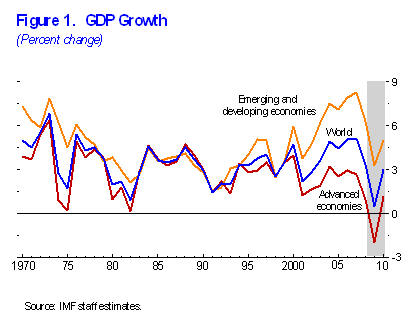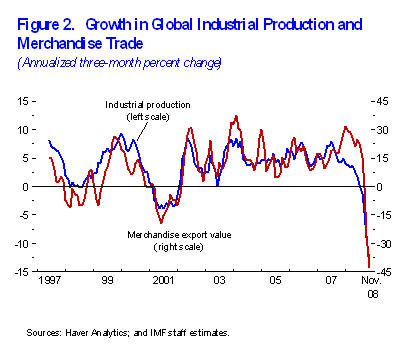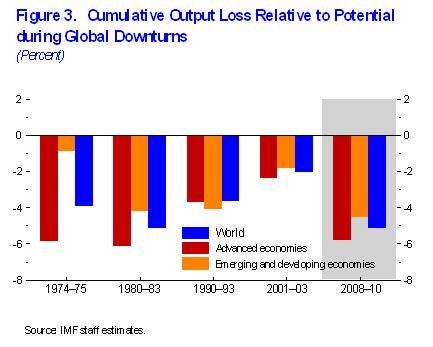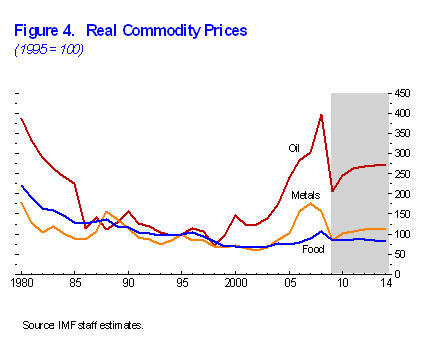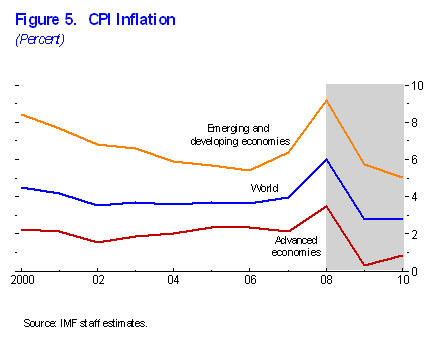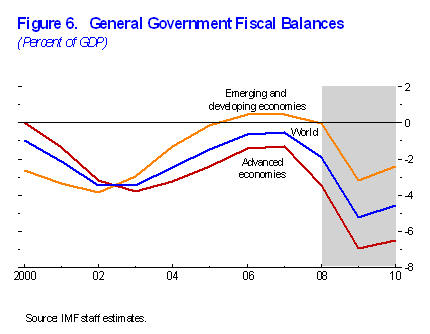World Economic Outlook
Global Economic Slump Challenges Policies
January 2009
World growth is projected to fall to ½ percent in 2009, its lowest rate since World War II. Despite wide-ranging policy actions, financial strains remain acute, pulling down the real economy. A sustained economic recovery will not be possible until the financial sector's functionality is restored and credit markets are unclogged. For this purpose, new policy initiatives are needed to produce credible loan loss recognition; sort financial companies according to their medium-run viability; and provide public support to viable institutions by injecting capital and carving out bad assets. Monetary and fiscal policies need to become even more supportive of aggregate demand and sustain this stance over the foreseeable future, while developing strategies to ensure long-term fiscal sustainability. Moreover, international cooperation will be critical in designing and implementing these policies.
The world economy is facing a deep downturn.
Global growth in 2009 is expected to fall to ½ percent when measured in terms of purchasing power parity and to turn negative when measured in terms of market exchange rates (Table 1.1 and Figure 1, view: Data Figure 1). This represents a downward revision of about 1¾ percentage point from the November 2008 WEO Update. Helped by continued efforts to ease credit strains as well as expansionary fiscal and monetary policies, the global economy is projected to experience a gradual recovery in 2010, with growth picking up to 3 percent. However, the outlook is highly uncertain, and the timing and pace of the recovery depend critically on strong policy actions.
Financial markets remain under stress.
Financial market conditions have remained extremely difficult for a longer period than envisaged in the November 2008 WEO Update, despite wide-ranging policy measures to provide additional capital and reduce credit risks.1 Since end-October, in advanced economies, spreads in funding markets have only gradually narrowed despite government guarantees, and those in many credit markets remain close to their peaks. In emerging economies, despite some recent moderation, sovereign and corporate spreads are still elevated. As economic prospects have deteriorated, equity markets in both advanced and emerging economies have made little or no gains. Currency markets have been volatile.
Financial markets are expected to remain strained during 2009. In the advanced economies, market conditions will likely continue to be difficult until forceful policy actions are implemented to restructure the financial sector, resolve the uncertainty about losses, and break the adverse feedback loop with the slowing real economy. In emerging economies, financing conditions will likely remain acute for some time—especially for corporate sectors that have very high rollover requirements.
A pernicious feedback loop between the real and financial sectors is taking its toll.
Global output and trade plummeted in the final months of 2008 (Figure 2, view: Data Figure 2). The continuation of the financial crisis, as policies failed to dispel uncertainty, has caused asset values to fall sharply across advanced and emerging economies, decreasing household wealth and thereby putting downward pressure on consumer demand. In addition, the associated high level of uncertainty has prompted households and businesses to postpone expenditures, reducing demand for consumer and capital goods. At the same time, widespread disruptions in credit are constraining household spending and curtailing production and trade.
Advanced economies are suffering their deepest recession since World War II.
Against this uncertain backdrop, output in the advanced economies is now expected to contract by 2 percent in 2009. This would be the first annual contraction during the postwar period, with a cumulative output loss (relative to potential) comparable to the 1974-75 and 1980-82 periods (Figure 3, view: Data Figure 3). Nevertheless, assuming more comprehensive and coordinated financial policy actions that support a gradual normalization of financial market conditions, as well as sizable fiscal stimulus and large interest rate cuts in many advanced economies, output is expected to start recovering in late 2009 and rise by about 1 percent in 2010. Stabilization in the U.S. housing market should help underpin recovery during this period.
Emerging and developing economies are experiencing a serious slowdown.
Growth in emerging and developing economies is expected to slow sharply from 6¼ percent in 2008 to 3¼ percent in 2009, under the drag of falling export demand and financing, lower commodity prices, and much tighter external financing constraints (especially for economies with large external imbalances). Stronger economic frameworks in many emerging economies have provided more room for policy support to growth than in the past, helping to cushion the impact of this unprecedented external shock. Accordingly, although these economies will experience serious slowdowns, their growth is projected to remain at or above rates seen during previous global downturns. Developing countries in Africa and elsewhere are also better prepared this time to face policy challenges because of improved macroeconomic policy implementation, but the continent is in a weaker position than most other regions because of its poverty levels and reliance on commodity exports.
Anemic global growth has reversed the commodity price boom.
The slump in global demand has led to a collapse in commodity prices (Figure 4, view: Data Figure 4). Despite production cutbacks and geopolitical tensions, oil prices have declined by over 60 percent since their peak in July 2008, although they remain higher in real terms than during the 1990s. The IMF's baseline petroleum price projection has been revised down to $50 a barrel for 2009 and $60 a barrel for 2010 (from $68 and $78, respectively, in the November WEO Update), and risks to this projection are on the downside. Metals and food prices have also been marked down in line with recent developments. These price declines have dampened growth prospects for a number of commodity-exporting economies.
Inflation pressures are subsiding.
Sluggish real activity and lower commodity prices have dampened inflation pressures (Figure 5, view: Data Figure 5). In the advanced economies, headline inflation is expected to decline from 3½ percent in 2008 to a record low ¼ percent in 2009, before edging up to ¾ percent in 2010. Moreover, some advanced economies are expected to experience a period of very low (or even negative) consumer price increases. In emerging and developing economies, inflation is also expected to subside to 5¾ percent in 2009 and 5 percent in 2010, down from 9½ percent in 2008.
Global monetary and fiscal policies are providing substantial support.
Faced with a quickly deteriorating outlook and subsiding inflation pressures, central banks in the advanced economies have taken strong actions to cut policy rates and improve credit provision. Policy interest rates have been brought down substantially in recent months, especially as inflation pressures subsided, although falling inflation expectations are mitigating the impact on real interest rates. Relative to the November WEO Update projections, short-term market interest rates in 2009 are assumed to be about ¾ percentage point lower in the United States, the euro area, and the United Kingdom, in line with market expectations. Central banks in emerging economies are also moving to ease their policy stance and improve market liquidity.
To combat the downturn, many governments have announced fiscal packages to boost their economies. Consequently, unlike the November WEO Update, the new projections incorporate a substantial fiscal expansion. Specifically, fiscal stimulus in G-20 countries in 2009 is projected to be 1.5 percent of GDP. Deficits are also expected to be boosted by the operation of automatic stabilizers and the impact on revenues of sharp asset price declines, as well as the costs of financial sector rescues. As a result, the fiscal balance in advanced economies is projected to deteriorate by 3¼ percentage points to -7 percent of GDP in 2009 (Figure 6, view: Data Figure 6).
The uncertainty surrounding the outlook is unusually large.
Downside risks continue to dominate, as the scale and scope of the current financial crisis have taken the global economy into uncharted waters. The main risk is that unless stronger financial strains and uncertainties are forcefully addressed, the pernicious feedback loop between real activity and financial markets will intensify, leading to even more toxic effects on global growth. In addition, the risks of deflation are rising in a number of advanced economies, while emerging economies' corporate sectors could be badly damaged by continued limited access to external financing.2 Furthermore, while fiscal policy is providing important short-term support, the sharp increase in the issuance of public debt could prompt an adverse market reaction, unless governments clarify their strategy to ensure long-term sustainability.
There are also upside risks. In particular, global financial conditions could improve faster than expected due to stronger policy actions. This could boost consumer and business confidence and alleviate the credit crunch, thereby lifting global growth.
Strong and complementary policy efforts are needed to rekindle activity.
Policy efforts so far have addressed the immediate threats to financial stability (through liquidity support, deposit insurance, and recapitalization schemes), but they have done little to resolve the uncertainty about the long-term solvency of financial institutions. The process of loss recognition and restructuring of bad loans is still incomplete. Therefore, financial sector policies should focus on advancing this process by forcing credible and coordinated loan loss recognition and by providing public support to the viable financial institutions. Such policies should be supported by measures to resolve insolvent banks and set up public agencies to dispose of the bad debts, including possibly through a "bad bank" approach, while safeguarding public resources.
Monetary policy remains an important policy lever. The projections incorporate a substantial easing in policy rates, although the effectiveness of interest rate cuts to support activity is likely to be constrained as long as financial conditions remain disrupted. With interest rates approaching zero in several major countries, central banks are exploring alternative policy approaches that rely on using their balance sheets to ease monetary conditions further. The focus should be on unlocking key (high-spread, low-liquidity) credit markets.
In current circumstances, the timely implementation of fiscal stimulus across a broad range of advanced and emerging economies must provide a key support to world growth.3 Given that the current projections are predicated on strong and coordinated policy actions, any delays will likely worsen growth prospects. Countries that have policy room should make a firm commitment to do more if the situation deteriorates further. Fiscal stimulus packages should rely primarily on temporary measures and be formulated within medium-term fiscal frameworks that ensure that the envisaged buildup in fiscal deficits can be reversed as economies recover and that fiscal sustainability can be attained in the face of demographic pressure. Countries that have more limited fiscal space should focus their efforts on supporting the financial sector and credit flows, while ensuring that budgets adjust to less favorable external conditions. However, it will be important to avoid cutbacks in foreign aid in response to tightening budget constraints, lest hard-won economic gains in developing countries are lost.
1 See the January 2009 Global Financial Stability Report—Market Update.
2 See Gauging Risks for Deflation, IMF Staff Position Note (SPN/09/01)
3 See Fiscal Policy for the Crisis, IMF Staff Position Note (SPN/08/01)



